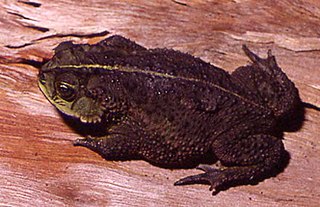
Clinopodium is a genus of flowering plants in the family Lamiaceae. It is in the tribe Mentheae of the subfamily Nepetoideae, but little else can be said with certainty about its phylogenetic position.
The white-winged serotine is a species of vesper bat.
The Ethiopian narrow-headed rat is a species of rodent in the family Muridae. It is found only in Ethiopia. Its natural habitats are subtropical or tropical high-altitude shrubland and subtropical or tropical high-altitude grassland.
The gray-tailed narrow-headed rat is a species of rodent in the family Muridae. It is found only in Ethiopia. Its natural habitats are subtropical or tropical moist montane forests, subtropical or tropical high-altitude shrubland, and subtropical or tropical high-altitude grassland. It is threatened by habitat loss.

Hypericum tortuosum is a species of flowering plant in the genus Hypericum. It is found only in Socotra, Yemen, where it is endemic. The species is an apomorphic relative of the other Socotran species in Hypericum sect. Triadenioides and is most closely related to Hypericum scopulorum. Its natural habitats are subtropical or tropical dry forests and subtropical or tropical dry shrubland.
Clinopodium mutabile is a species of flowering plant in the family Lamiaceae. It is found only in Ecuador. Its natural habitat is subtropical or tropical dry shrubland.

Rhinella fernandezae is a species of toad in the family Bufonidae that is found in Argentina, Brazil, Paraguay, and Uruguay. Its natural habitats are subtropical or tropical dry lowland grassland, subtropical or tropical seasonally wet or flooded lowland grassland, intermittent freshwater marshes, coastal freshwater lagoons, arable land, pastureland, plantations, and seasonally flooded agricultural land.
"Bufo" scorteccii is a species of toad in the family Bufonidae. It is endemic to Yemen. Its natural habitats are subtropical or tropical dry shrubland and freshwater springs.

The eastern smooth frog, or Victorian smooth froglet, is a species of frog in the family Myobatrachidae. It is endemic to Australia. Its natural habitats are subtropical or tropical dry forests, subtropical or tropical moist lowland forests, subtropical or tropical dry shrubland, subtropical or tropical moist shrubland, subtropical or tropical high-altitude shrubland, subtropical or tropical dry lowland grassland, swamps, and intermittent freshwater marshes.

The long-snout torrent frog is a species of frogs in the family Ranidae.
The Zhenhai brown frog is a species of frog in the family Ranidae endemic to China. Its natural habitats are subtropical or tropical moist lowland forests, subtropical or tropical moist montane forests, subtropical or tropical dry lowland grasslands, intermittent freshwater marshes, ponds, and irrigated land. It is not considered threatened by the IUCN.

Polypedates cruciger is a species of frog in the family Rhacophoridae endemic to Sri Lanka.

Kurixalus naso is a species of frog in the family Rhacophoridae. It is found in northeastern India, Tibet, and Myanmar. Its natural habitats are subtropical or tropical dry forests, subtropical or tropical moist montane forests, subtropical or tropical moist shrubland, subtropical or tropical seasonally wet or flooded lowland grassland, and intermittent freshwater marshes. It is threatened by habitat loss.

The greater hedgehog tenrec, also known as the large Madagascar hedgehog or sokina, is a species of mammal in the family Tenrecidae. It is endemic to Madagascar. Its natural habitats are subtropical or tropical dry forest, subtropical or tropical moist lowland forest, subtropical or tropical moist montane forest, dry savanna, moist savanna, subtropical or tropical dry shrubland, subtropical or tropical moist shrubland, subtropical or tropical high-altitude shrubland, subtropical or tropical dry lowland grassland, subtropical or tropical high-altitude grassland, rural gardens, urban areas and zoos.

Buettikofer's shrew is a species of mammal in the family Soricidae. It is found in southern Nigeria and scantly present in Ivory Coast, Ghana, Guinea, Liberia and Sierra Leone. Its natural habitat is subtropical or tropical moist lowland forests. It is threatened by habitat loss.

The Ugandan lowland shrew is a species of mammal in the family Soricidae. It is found in Kenya and Uganda. Its natural habitats are subtropical or tropical swamps and subtropical or tropical moist montane forest. It is threatened by habitat loss.

Babault's mouse shrew is a species of mammal in the family Soricidae found in Burundi, the Democratic Republic of the Congo, and Uganda. Its natural habitat is subtropical or tropical moist montane forests. It is threatened by habitat loss.

The moon forest shrew is a species of mammal in the family Soricidae. It is found in Burundi, Rwanda, and Uganda. Its natural habitat is subtropical or tropical moist montane forests.

The Mount Cameroon forest shrew is a species of mammal in the family Soricidae endemic to Cameroon. Its natural habitat is subtropical or tropical moist montane forests.

The Aldabra flying fox is a species of megabat in the genus Pteropus. It is endemic to the Aldabra Atoll in the Seychelles, like Chaerephon pusilla, though the latter may be the same species as the little free-tailed bat.














